March 16, 2020 feature
Mechanically controllable nonlinear dielectrics
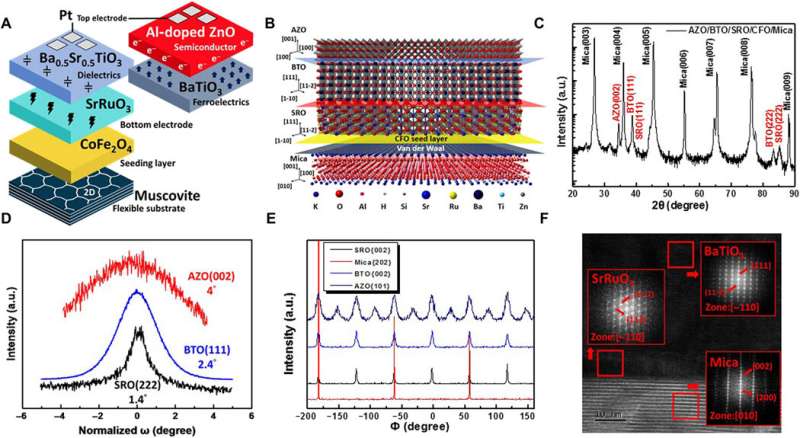
Strain-sensitive barium strontium titanate (Bax-Sr1-x-TiO3) perovskite systems are widely used for their superior nonlinear dielectric behaviors. In a new report on Science Advances, D.L. Ko and a research team in materials science and engineering, physics, electronics and information engineering in Taiwan, Hong Kong and the U.S. has developed new heterostructures including paraelectric Ba0.5Sr0.5TiO3 (BSTO) and ferroelectric BaTiO3 (BTO) epitaxially on a flexible muscovite substrate. The application of mechanical force through simple bending regulated the dielectric constant (electric energy potential) for BSTO ranging from -77 to 36%, as well as the channel current of BTO-based ferroelectric field effect transistors, by two orders. Ko et al. studied the detailed mechanism by exploring phase transition and band structure determination to implement phase-field simulations and provide theoretical support. The field opens a new avenue for mechanically controllable components based on high-quality oxide heteroepitaxy.
The periodic configuration of atoms in a solid is a consequence of energy minimization, where the involved atoms and their corresponding arrangement can determine the properties of materials. As a result, materials scientists can dynamically tune the periodicity of atom arrangements or strain applications in a fundamental approach to tune material functionalities. Researchers had previously proposed several approaches to impose strain on materials—including the application of hydrostatic pressure to observe the shift of diffraction peaks via X-ray analysis as direct evidence of lattice alteration through external force. For example, external stimuli such as magnetic fields, electric fields and light illumination can undergo a change of lattice due to magnetostriction, electrostriction and photostriction. The concept of applying mechanical force to materials can be realized through manual bending as it is the simplest method to cause material deformation. In order to impose strain without the absorption by defect formation, materials scientists require high-quality materials such as single crystals or epitaxial films, although most single crystals cannot be mechanically bent.
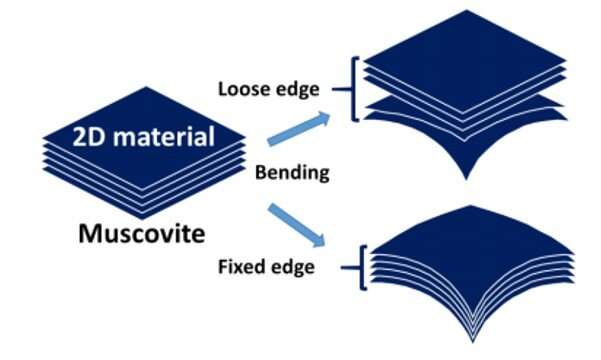
Two-dimensional (2-D) layered oxide muscovites are an eligible candidate due to their superior mechanical flexibility and high melting point (~12600C to 12900C). If a strain can be applied to a nonlinear dielectric lattice, then it can change its ability for charge storage and the magnitude of ferroelectric polarization. Nonlinear dielectric materials offer strong coupling between the lattice structure and properties and among the traditional nonlinear dielectrics—non-toxic perovskite BaxSr1-xTiO3 systems have shown high sensitivity to strain application. As a result, Ko et al. selected paraelectric Ba0.5Sr0.5TiO3 (BSTO) and ferroelectric BaTiO3 as model systems in the present study to exhibit control by mechanical bending.
The research team tuned the ferroelectric-to-paraelectric phase transition of the BaxSr1-xTiO3 system to control the corresponding dielectric and ferroelectric properties via mechanical bending. They used capacitance-voltage (CV), polarization voltage (PV) and current-voltage (IV) measurements to characterize the dielectric constant of BSTO and ferroelectric properties of BTO. They also built a ferroelectric field effect transistor (FeFET) on the basis of BTO with high mobility aluminium-doped zinc oxide (AZO) semiconductor layer and measured its channel current to study the bending effect on the BSTO capacitor and BTO FeFET. The team observed the change of lattice under bending using Raman spectroscopy and used X-ray photoelectron spectroscopy to highlight the influence of BTO polarization on the electronic structure in the semiconductor AZO layer under diverse bending conditions.
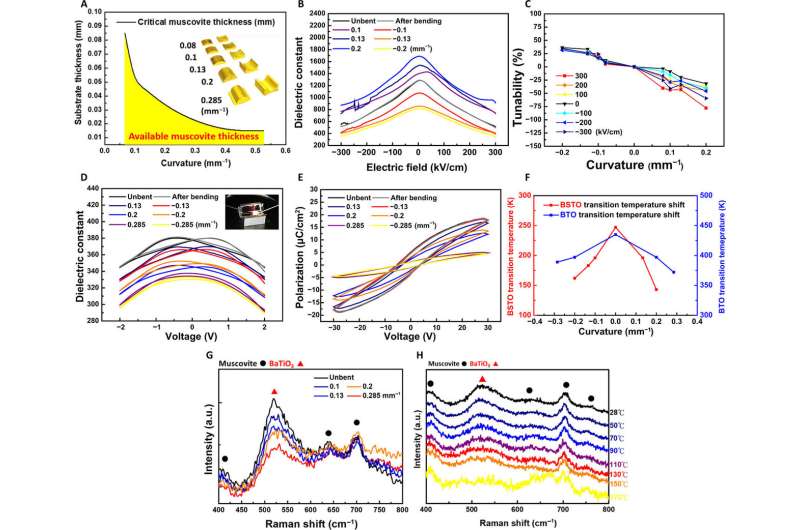
Ko et al. engineered the BSTO capacitor and the BTO FeFET systems on muscovite substrates with superior crystallinity, which the team examined using X-ray diffraction. They noted high crystalline quality of the heterostructure without secondary phases and calculated the crystal quality of each layer using the rocking curve measurement. To examine the microstructure of the material they characterized the heterostructure with high resolution transmission electron microscopy and investigated strain by mechanical bending using muscovite substrates due to their mechanical flexibility, where thinner muscovites showed better bending during the experiments.
The team imposed strain through mechanical bending to observe changes in BTO ferroelectricity and the dielectric constant of BSTO. They conducted capacitance-voltage (CV) and polarization-voltage (PV) measurements to understand if polarization intensity of BTO gradually weakened under mechanical bending. The electric tunability of BSTO capacitor reached about 60 to 70%, indicating high quality of the heterostructures, and the dielectric constant could be regulated by the electric field alone, while increasing or decreasing under positive (tensile strain) and negative (compressive strain) bending curvatures. Ko et al. tuned the amount of charge stored in this dielectric material by stretching the lattice architecture and noted that behaviors relative to the nonlinear dielectric properties could be controlled and repeated under mechanical bending, with great potential in practice.
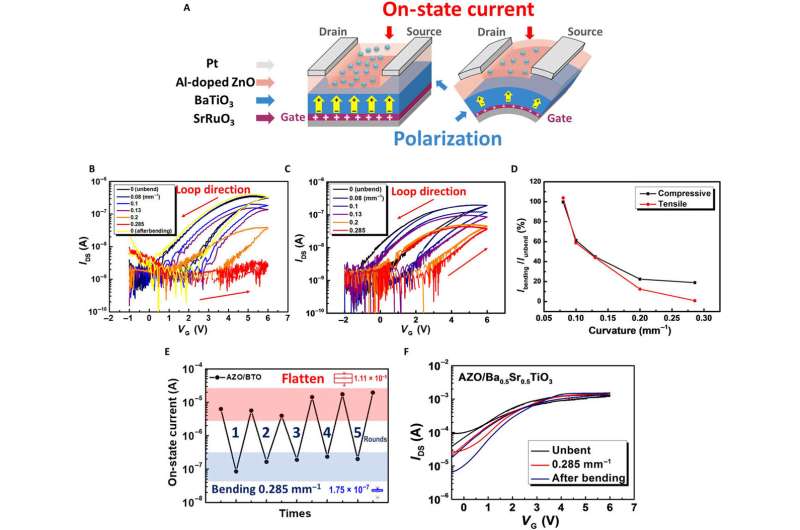
The team then investigated the ability for mechanical bending to alter ferroelectric properties through multi-measurements including temperature-dependent Raman spectroscopy to study the phase transition of ferroelectric materials. The results provided direct evidence to control the ferroelectric state through mechanical bending and further design optimization of the device allowed them to convert a simple and tunable ferroelectric capacitor to a mechanically controlled transistor. Both compressive and tensile bending decreased the on-state current—but the strain effect was obvious under tensile bending. The scientists confirmed the AZO/BTO/SRO(Strontium ruthenate) /muscovite substrate to be a mechanically controllable transistor. The team confirmed these effects using piezoresponse force microscopy (PFM) and Kelvin probe force microscopy (KPFM).
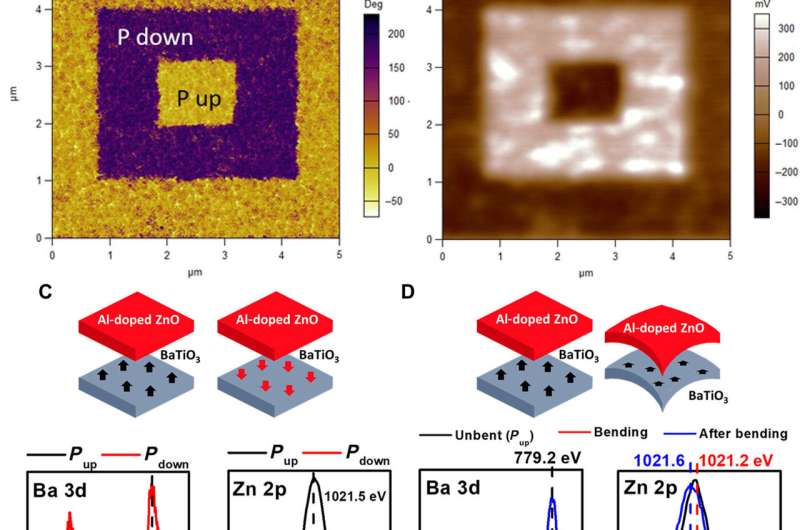
In this way, D.L. Ko and colleagues developed a flexible oxide heteroepitaxial capacitor and FeFET, using paraelectric BSTO, ferroelectric BTO and semiconducting AZO layers on a 2-D muscovite substrate. The BSTO capacitor showed high tunability of its dielectric constant under mechanical bending. In the FeFET component, they reached a two-order-of-magnitude change in the ratio of on/off current relative to BTO ferroelectricity. The results of the study provided them with critical insights of the mechanism, in which flexible and tunable electrical properties were possible through simple mechanical bending. This breakthrough will provide a promising path for future applications of mechanically tunable technology.
More information: Ying-Hao Chu. Van der Waals oxide heteroepitaxy, npj Quantum Materials (2017). DOI: 10.1038/s41535-017-0069-9
D. L. Ko et al. Mechanically controllable nonlinear dielectrics, Science Advances (2020). DOI: 10.1126/sciadv.aaz3180
Journal information: Science Advances
© 2020 Science X Network





















